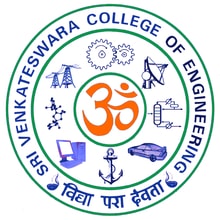OLD FLASH NEWS ARCHIVES
| Date | Title | Content |
|---|---|---|
|
11th - July - 2025
|
Dr.M A Chidambaram- Inter School Cricket Trophy 2025
|
Click here to view the Brochur
Registration Link: Click here
|
|
8th - July - 2025
|
Fees structure for the students allotted through TNEA 2025
|
|
|
8th - July - 2025
|
Dress Code for Students
|
Dress Code for all the Students
Click here to view the Circular for the Dress code of all the Students
|
|
8th - July - 2025
|
MSME Idea Hackathon 5.0
|
SVCE EPIC organizing sensitization workshop for MSME Idea Hackathon 5.0 on 10.07.2025(3.15-4.15 PM) at SVCE EPIC office(II Floor IMS Block).Faculty members and students are requested to attend the workshop.
|
|
20th - June - 2025
|
Revaluation Circular - 2024 - 2025
|
Revaluation Circular - 2024 - 2025 for VIII Sem UG and IV Sem PG students
(Only to those students whose results have been published)
All the UG 8th and PG 4th semester students are instructed to register your name and subject code for the photocopy of the revaluation
|
|
29th - May - 2025
|
Applications are invited for Web Designer (in Wordpress)
|
Click Here to view the Job Overview
Apply to : hr@svce.ac.in
|
|
20th - May - 2025
|
Six-Day Online Faculty Development Programme (FDP) on "Sustainable Mobility Solutions and Emission Control in Automobiles
|
|
|
12th - May - 2025
|
FAT – III Schedule and Seating Arrangement for I, II and III year UG Students-2024-25(ES) -reg
|
|
|
9th - May - 2025
|
FAT - II Circular for Honors and Minor Subjects (Even Semester, AY 2024-2025)
|
FAT-II Circular for the Honors and Minor subjects of the Even Semester for third-year UG students for the academic year 2024-2025.
Click here to view the Schedule of FAT-II for the Honors and Minor subjects
|
|
9th - May - 2025
|
Fees circular 2025-26 for Senior Students
|
|
|
8th - May - 2025
|
Seating plan for 08.05.2025
|
Seating plan for 08.05.2025
Click here to view the Seating Plan for 8th May 2025
|
|
7th - May - 2025
|
Six-Day Faculty Development Program on "Emerging Trends and Advancements in Chemical and Food Processing Technology"
|
Warm Greetings from ChE, SVCE !
The Department of Chemical Engineering is pleased to cordially invite you to participate in the upcoming Six-Day Faculty Development Program (FDP) titled: “Emerging Trends and Advancements in Chemical and Food Processing Technology (EACFT 2025)”
This program will be conducted in hybrid mode from May 30, 2025 to June 5, 2025, at the Central Library Seminar Hall, Sri Venkateswara College of Engineering (SVCE).
We warmly welcome all faculty members to join us in this enriching FDP and be a part of the academic exchange and knowledge advancement.
We look forward to your valuable presence!
Click Here to view the Brochure
|
|
5th - May - 2025
|
Formative Assessment Test III – UG Students(II, IV & VI Semesters)-2024-25 ES
|
Circular for Formative Assessment Test III – UG Students(II, IV & VI Semesters)-2024-25 ES
Click here to view the Circular
Circular for FAT-III
|
|
29th - April - 2025
|
May 2025 Summative Examination Schedule
|
|
|
24th - April - 2025
|
National Conference on Communication and Informatics (NCCI-2025)
|
National Conference on Communication and Informatics (NCCI-2025)
Organized by the Department of Information Technology
Date: May 8, 2025
Click here to download the Brochure
Click here to more Details in Below Website. 👉NCCI_2025 |
|
15th - April - 2025
|
Applications are invited for the position of Junior Research Fellow (Temporary) in the BIS sponsored project
|
|
|
8th - April - 2025
|
Newspaper Clippings for College day 2025.
|
|
|
18th - February - 2025
|
List of Final UG projects selected for SVCE Intramural grant for the AY 2024-2025.
|
|
|
12th - February - 2025
|
AICTE feedback - Web portal link for Students and Faculty
|
As per the AICTE's directions, the web portal link for the Students and Faculty feedback is made available through the college website.
Click here to open the Feedback web portal
|
|
28th - January - 2025
|
MATLAB and Simulink - Campus-wide license - Installation procedure
|
We are pleased to announce that Sri Venkateswara College of Engineering has successfully renewed the campus-wide license for MATLAB and Simulink, including all add-on products. This renewal ensures that the academic community of Sri Venkateswara College of Engineering has full access to these powerful tools for instruction, research, and personal projects.
MATLAB and Simulink -Campus-wide license - installation. Click here to view further details
Important: To maintain uninterrupted access to MATLAB and Simulink, individuals currently using MATLAB Campus License must update their license information.
Please follow the instructions below:
1. Ensure that your computer is connected to the internet.
2. Launch MATLAB.
3. If you encounter a license expiration error, please close MATLAB and then reopen it.
4. You may be prompted to sign in with your MathWorks account.
Should the users continue to experience problems, feel free to contact MathWorks Support at this Link:
Click here to view the Contact Support
|
|
28th - December - 2024
|
Hindu Tamizh article published 28/12/2024 - AICTE sponsored ATAL FDP
|
An article has been published in Hindu Tamizh dated 28/12/24 showcasing AICTE sponsored ATAL FDP on "Advanced Semiconductor Devices and AI Chips - Research Opportunities and Challenges" organized by SVCE. Click here to view the News Article |
|
27th - December - 2024
|
Invitation to the SATY Summer Camp 2025 at SVCE
|
Greetings from SVCE! We are pleased to inform you that Springboards, Chennai, and Sri Venkateswara College of Engineering (SVCE), in association with AIMST University, Malaysia, are organizing the 7th Summer Camp on "Engineering & Technology for School Children" (SATY 2025). The camp is scheduled to be held from 5th to 9th May 2025 for school students from classes 8 to 12. A brochure and registration form for the event are attached for your reference. 👉Click here to view the Brochure and Registration Form |
|
29th - November - 2024
|
College will be closed tomorrow (30/11/2024) due to the inclement weather forecast declared by Govt of Tamilnadu
|
College will be closed tomorrow (30/11/2024) due to the inclement weather forecast declared by Govt of Tamilnadu
Also, the examinations scheduled on 30/11/2024 are cancelled and will be conducted later. The rescheduled date will be intimated by the COE.
PRINCIPAL
|
|
22nd - November - 2024
|
List of final year PG projects selected for Intramural funding -Academic Year(2024-2025)
|
To view the PG intramural funding-Academic Year(2024-2025)(click here) |
|
19th - September - 2024
|
Seeds and Wings Scholarship Distribution Ceremony
|
|
|
24th - July - 2024
|
Availability of Fabrication and Testing Facilities for Planar Microwave Components
|
|
|
5th - July - 2024
|
Awardees of Alumni Scholarship from 1985-89 Batch – for the Academic Year 2024-25
|
"Greetings!!! The SVCE Alumni from the 1985-89 batch have been sponsoring the tuition fees for a group of Girl students from their Second year to Final year based on their financial need and good academic performance in the first year of study, to enable them to carry out their studies without worrying about the financial requirements. Awardees are also supported beyond the classroom by arranging internships and even providing them with job opportunities, if found suitable. Congratulations to Ms. Kirthika A, III-Year CS, Ms. Prathika P R, III-Year AD, Ms. Swetha S, III-Year EC, Ms. Aarthi A, III-Year IT, Ms.Harini A, II-Year CE, Ms.Janani E, II-Year CS, Ms.Viswasree S, II-Year EE, Ms.Yuvasri A, II-Year EC, Ms.Monika S, II-Year IT, and Ms.Pooja S, II-Year ME for being the seventh batch of students to avail the scholarship instituted by the SVCE 1985-89 batch. |
|
23rd - April - 2024
|
Fee Circular 2024-25
|
Fee Circular 2024-25
Click To download the Fee Circular 2024-25
|
|
4th - December - 2020
|
SVCE - Draft Standard Operating Procedures and Cleaning Guidelines to prevent COVID-19 & Instructions to the Visitors
|






